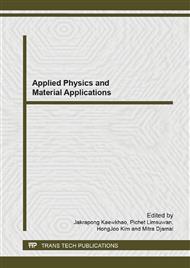p.161
p.165
p.169
p.173
p.177
p.181
p.185
p.189
p.193
Effect of Sputtering Power on Structural and Optical Properties of AlN Thin Film Deposited by Reactive DC Sputtering Technique
Abstract:
Aluminum nitride (AlN) thin films have been deposited on the glass slide and Si-wafer by reactive DC magnetron sputtering technique at different sputtering power. The as-deposited films have been characterized by grazing-incidence X-ray diffraction (GIXRD), atomic force microscopy (AFM) and optical transmittance, respectively. The results show that the as-deposited films were transparent and have high transmittance in visible regions. The crystal structure from XRD results show that the as-deposited films are amorphous with low sputtering power and turn to crystal structure with high sputtering power, which showed orientation of AlN structure corresponding to the AlN(1 0 0), AlN(1 0 1) and AlN(1 1 0). The roughness values and the films thickness from AFM was varied from 0.4 nm to 3.9 nm and 199 nm to 905 nm, respectively. The optical constants namely the refractive index n and the extinction coefficient k, were determined from transmittance spectrum in the visible regions by using envelope method. For 500 nm, n and k, were in the range of 1.8 2.0 and 0.014 0.004 respectively.
Info:
Periodical:
Pages:
177-180
Citation:
Online since:
September 2013
Authors:
Keywords:
Price:
Сopyright:
© 2013 Trans Tech Publications Ltd. All Rights Reserved
Share:
Citation:


